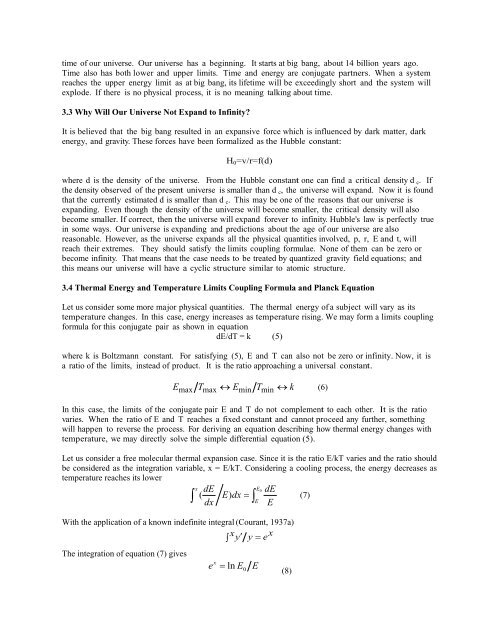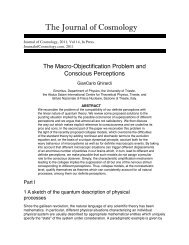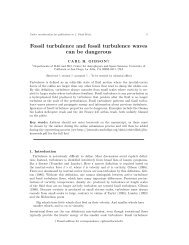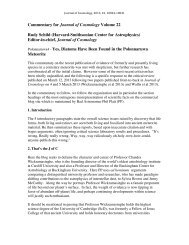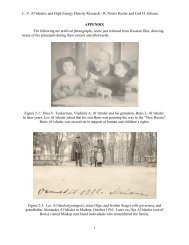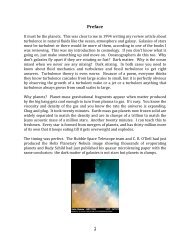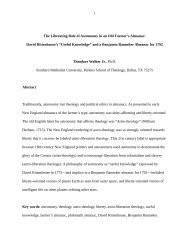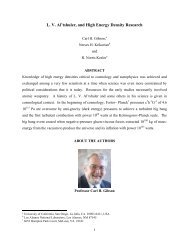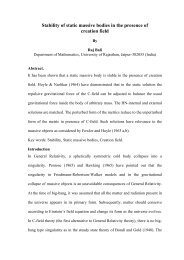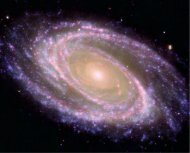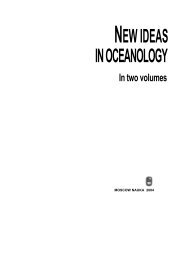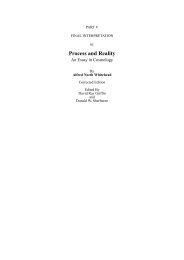The Quantization of Classical Fields Equations and the Cyclic ...
The Quantization of Classical Fields Equations and the Cyclic ...
The Quantization of Classical Fields Equations and the Cyclic ...
You also want an ePaper? Increase the reach of your titles
YUMPU automatically turns print PDFs into web optimized ePapers that Google loves.
time <strong>of</strong> our universe. Our universe has a beginning. It starts at big bang, about 14 billion years ago.<br />
Time also has both lower <strong>and</strong> upper limits. Time <strong>and</strong> energy are conjugate partners. When a system<br />
reaches <strong>the</strong> upper energy limit as at big bang, its lifetime will be exceedingly short <strong>and</strong> <strong>the</strong> system will<br />
explode. If <strong>the</strong>re is no physical process, it is no meaning talking about time.<br />
3.3 Why Will Our Universe Not Exp<strong>and</strong> to Infinity?<br />
It is believed that <strong>the</strong> big bang resulted in an expansive force which is influenced by dark matter, dark<br />
energy, <strong>and</strong> gravity. <strong>The</strong>se forces have been formalized as <strong>the</strong> Hubble constant:<br />
H0=v/r=f(d)<br />
where d is <strong>the</strong> density <strong>of</strong> <strong>the</strong> universe. From <strong>the</strong> Hubble constant one can find a critical density d c. If<br />
<strong>the</strong> density observed <strong>of</strong> <strong>the</strong> present universe is smaller than d c, <strong>the</strong> universe will exp<strong>and</strong>. Now it is found<br />
that <strong>the</strong> currently estimated d is smaller than d c. This may be one <strong>of</strong> <strong>the</strong> reasons that our universe is<br />
exp<strong>and</strong>ing. Even though <strong>the</strong> density <strong>of</strong> <strong>the</strong> universe will become smaller, <strong>the</strong> critical density will also<br />
become smaller. If correct, <strong>the</strong>n <strong>the</strong> universe will exp<strong>and</strong> forever to infinity. Hubble's law is perfectly true<br />
in some ways. Our universe is exp<strong>and</strong>ing <strong>and</strong> predictions about <strong>the</strong> age <strong>of</strong> our universe are also<br />
reasonable. However, as <strong>the</strong> universe exp<strong>and</strong>s all <strong>the</strong> physical quantities involved, p, r, E <strong>and</strong> t, will<br />
reach <strong>the</strong>ir extremes. <strong>The</strong>y should satisfy <strong>the</strong> limits coupling formulae. None <strong>of</strong> <strong>the</strong>m can be zero or<br />
become infinity. That means that <strong>the</strong> case needs to be treated by quantized gravity field equations; <strong>and</strong><br />
this means our universe will have a cyclic structure similar to atomic structure.<br />
3.4 <strong>The</strong>rmal Energy <strong>and</strong> Temperature Limits Coupling Formula <strong>and</strong> Planck Equation<br />
Let us consider some more major physical quantities. <strong>The</strong> <strong>the</strong>rmal energy <strong>of</strong> a subject will vary as its<br />
temperature changes. In this case, energy increases as temperature rising. We may form a limits coupling<br />
formula for this conjugate pair as shown in equation<br />
dE/dT = k (5)<br />
where k is Boltzmann constant. For satisfying (5), E <strong>and</strong> T can also not be zero or infinity. Now, it is<br />
a ratio <strong>of</strong> <strong>the</strong> limits, instead <strong>of</strong> product. It is <strong>the</strong> ratio approaching a universal constant.<br />
Emax Tmax<br />
↔ Emin<br />
Tmin<br />
↔ k (6)<br />
In this case, <strong>the</strong> limits <strong>of</strong> <strong>the</strong> conjugate pair E <strong>and</strong> T do not complement to each o<strong>the</strong>r. It is <strong>the</strong> ratio<br />
varies. When <strong>the</strong> ratio <strong>of</strong> E <strong>and</strong> T reaches a fixed constant <strong>and</strong> cannot proceed any fur<strong>the</strong>r, something<br />
will happen to reverse <strong>the</strong> process. For deriving an equation describing how <strong>the</strong>rmal energy changes with<br />
temperature, we may directly solve <strong>the</strong> simple differential equation (5).<br />
Let us consider a free molecular <strong>the</strong>rmal expansion case. Since it is <strong>the</strong> ratio E/kT varies <strong>and</strong> <strong>the</strong> ratio should<br />
be considered as <strong>the</strong> integration variable, x = E/kT. Considering a cooling process, <strong>the</strong> energy decreases as<br />
temperature reaches its lower<br />
x<br />
dE<br />
dx<br />
∫ = ∫<br />
0<br />
( E)<br />
dx<br />
E<br />
E<br />
dE<br />
E<br />
With <strong>the</strong> application <strong>of</strong> a known indefinite integral (Courant, 1937a)<br />
x<br />
y y = e<br />
x<br />
∫ ′<br />
<strong>The</strong> integration <strong>of</strong> equation (7) gives<br />
e x<br />
= ln E<br />
0<br />
E<br />
(8)<br />
(7)


